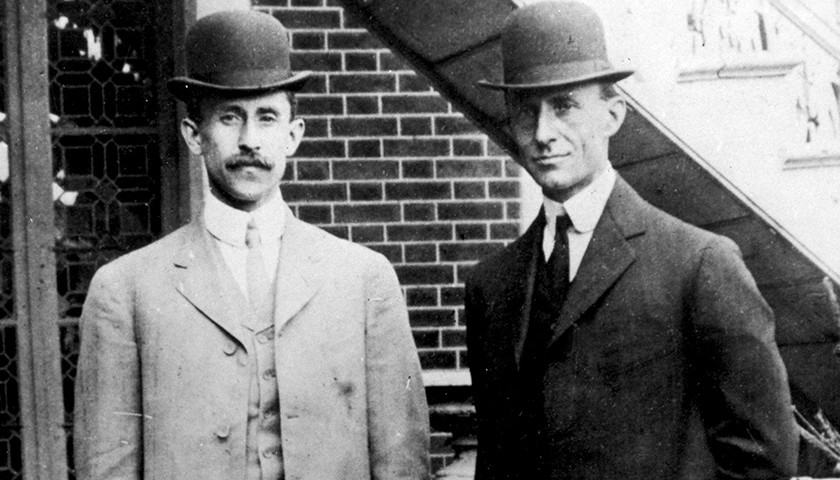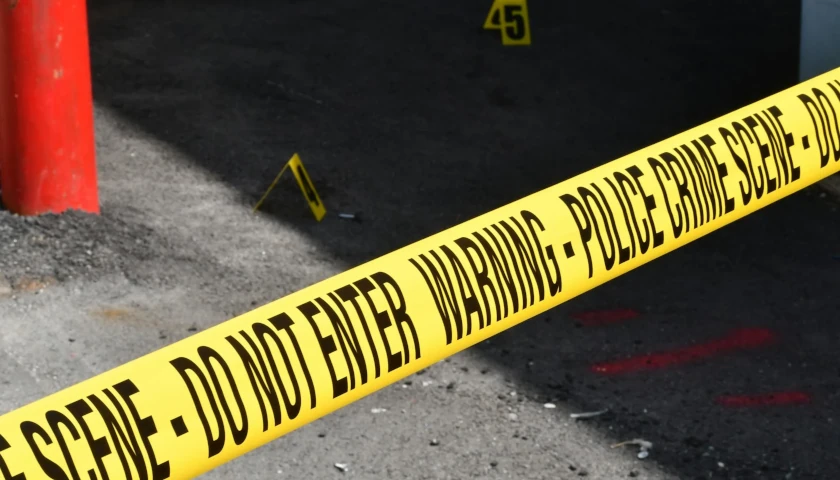How do you tell the story of the brothers who gave mankind the gift of flight? The men who realized ancient man’s distant dream of taking to the sky? It’s a daunting task, but luckily other gifted historians have attempted to tell their story.
Wilbur Wright was born near Millville, Indiana on April 16, 1867 in one of several homes his pastor father occupied before permanently settling in Dayton, Ohio. It was here, in the famous 7 Hawthorn Street house, that Orville was born on August 19, 1871. The two were separated by a set of twins named Otis and Ida who both died in infancy. They had a younger sister, Katherine, and two older brothers, Reuchlin and Lorin, who later in life would move “from job to job, trying to make ends meet for their families.” Historian David McCullough suggests in his account of their lives that the elder brothers’ toiling gave “Wilbur and Orville further reason to remain single.”
Their father, Milton, was a bishop in the Church of the United Brethren in Christ. He and his wife, Susan, imbued their children with an appreciation for the “importance of family.”
“The Wrights’ parents taught their children that the world was an unfriendly place; unscrupulous persons lay in wait and temptations beckoned. They were convinced that the strength of family bonds offered the only real support in life. Their mutual support enabled the family to weather all manner of crises,” states the Smithsonian National Air and Space Museum.
Wilbur and Orville were inseparable from an early age, as their father would say. “Inseparable as twins,” Milton said of his boys, who were “indispensable” to each other, McCullough recounts.
It was in 1889 that the Wrights suffered the “worst blow the family had ever known.” Their mother, Susan Catherine Koerner, died after a long battle with tuberculosis. That same year, Orville launched a printing business while still a teenager and Wilbur joined him on the endeavor, snapping him out of his depression.
During a fateful hockey accident in the winter of 1886, Wilbur was hit in the face with a stick and lost most of his upper front teeth. He suffered excruciating pain, was fitted with false teeth, experienced serious digestive problems and heart palpitations as well as spells of depression. Up until this point, Wilbur had excelled as both a student and an athlete, and the family talked of sending him to Yale, but all of those plans ended after the accident.
McCullough notes that the boy who struck Wilbur with a stick became one of the most notorious murderers in Ohio’s history. Oliver Crook Haugh was executed in 1906 for the murders of his mother, father, and brother and is believed to have killed up to a dozen others. As a teenager, he lived just two blocks from the Wrights and was known as the neighborhood bully.
“The whole episode seems to have been something the family wished to put behind them and remains a dark corner in Wilbur’s life about which too little is known. But clearly it changed the course of his life,” McCullough writes.
In any case, it was Wilbur’s younger brother’s ambition that restored purpose to his life. They built a large, professional press together so they could accept big jobs and began publishing several local newspapers and church pamphlets. They maintained their printing business until 1899 and relied on it as a source of income to fund their aeronautical experiments. Their venture into the printing business also established their close working relationship and was the first time the moniker “the Wright brothers” was used.
By 1893, the Wright brothers turned their attention to bicycles after building reputations as reliable mechanics and receiving numerous requests from friends to fix theirs bikes. They opened up a small rental and repair shop, which served as a more suitable outlet for their mechanical interests.
In their third year in business, the brothers moved to a new building that had space for a machine shop and began building their own model bicycles that were available to order. Their top-of-the-line model was called the Van Cleve and sold for $65. Between their peak production years of 1896 to 1900, it’s estimated that the Wright brothers built about 300 bicycles and earned $2,000 to $3,000 a year.
“Knowledge and experience with bicycles proved valuable to the Wrights’ development of a successful airplane,” the Smithsonian suggests.
The Flyer
The Wright brothers began their inquiry into “flying machines” in 1899 when Wilbur sent a letter to the Smithsonian seeking information on previous attempts at flight.
“I am an enthusiast, but not a crank in the sense that I have some pet theories as to the proper construction of a flying machine. I wish to avail myself of all that is already known and then if possible add my mite to help on the future worker who will attain final success,” he said in his letter.
They were surprised to learn how little progress had been made before the 1800s, mostly due to the fact that “few trained scientists or mechanics thought it a sensible undertaking,” the Smithsonian states.
From the outset, the Wright brothers reduced their obstacles down to three: a set of lifting surfaces, or wings, a method for controlling and balancing the aircraft, and a means of propulsion. Earlier aeronautical experimenters thought that an aircraft needed to be “inherently stable” because air currents were too “unpredictable for human reflexes.” From their experience with bicycles, however, the Wright brothers observed that a machine could be both unstable yet controllable.
The brothers reached a breakthrough when they developed the concept of “wing-warping,” a method of twisting the wing structure itself so a pilot could maintain balance.
“The Wrights realized that if the wing on one side of the aircraft met the oncoming flow of air at a greater angle than the opposite wing, it would generate more lift on that side. In response, that wing would rise, causing the aircraft to bank. If the pilot could manipulate the wings in this way, he could maintain balance and turn the aircraft as well,” the Smithsonian explains.
They also developed a 3-axis control system that allowed for turning left and right, moving up and down, and banking a turn, similar to leaning to one side on a bike.
These concepts were actually first confirmed in the 1902 Wright glider, which to a large extent “marked the invention of the airplane.” In fact, they used the designs for their 1902 glider, as opposed to the 1903 flyer, as the basis for their first successful patent for “improvements in flying-machines.”
After clearing the final hurdle of building their own propulsion system, the Wright brothers made four brief flights on December 17, 1903 at Kitty Hawk, North Carolina with their first powered aircraft. They had invented the first successful airplane.

They had selected Kitty Hawk because of its strong, steady winds and wide-open spaces. By 1905, they had completed their third powered airplane and routinely made flights of more than several minutes. Unfortunately, their later years were consumed by business dealings and frivolous lawsuits.
“When we think what we might have accomplished if we had been able to devote this time to experiments, we feel very sad, but it is always easier to deal with things than with men, and no one can direct his life entirely as he would choose,” Wilbur wrote to a friend.
Wilbur died at the age of 45 from typhoid, while Orville died at the age of 77 from a heart attack.
– – –
Anthony Gockowski is managing editor of Battleground State News, The Ohio Star, and The Minnesota Sun. Follow Anthony on Twitter. Email tips to anthony.gockowski@gmail.com.





[…] the Wright brothers, Curtiss began his own bicycle business, designing, building, and repairing the vehicles for the […]
[…] the Wright brothers, Curtiss began his own bicycle business, designing, building, and repairing the vehicles for the […]
[…] the Wright brothers, Curtiss began his own bicycle business, designing, building, and repairing the vehicles for the […]